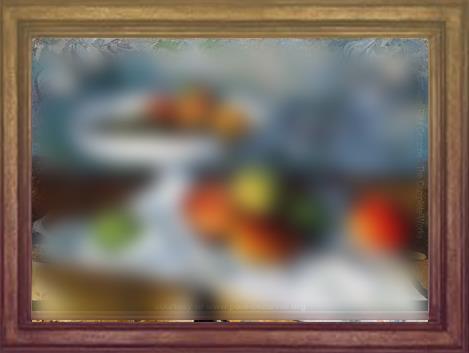This is a new problem; the American serial Bewitched did not have an issue in showing original art.
In a world where reality television has become king, that very ‘realness’ has become as produced as the ‘non-real’.
The penny dropped for Sydney-based artist, lecturer and curator, Dr Oliver Watts while watching the US-program Keeping up with the Kardashians that all the artwork in their apartment has been blurred. ‘Hipsters love the Kardashians because from a cultural perspective they are often an uncanny selfie of our times. But it is not good news for art,’ said Watts.’
Watts spoke at the Voice of the Artist symposium presented by Copyright Agency during this year’s recent Vivid programming. His point was that this ‘bureaucratic computerised hand in post’ that is removing art from television and film is now deciding how we see and read images.
‘There is a point of wanting to see art in middle class and normal homes otherwise we leave art to the connoisseurs and the super rich,’ he added. ‘We will see art disappear from everyday lives … and TV does have a role to play in that regard.’
‘As I looked around television and print media, it occurred to me that everywhere I looked, where once you would have expected art, there was none. On architectural and interior design show, art had been replaced by emptiness, a close crop, a feature wall or worse still the contestants’ DIY canvases (whose copyright was ceded to the show in advance),’ writes Watts.
What is at stake here is that there are a whole lot of nervous producers who are side-stepping the presentation of culture in television and film as a ‘risk averse’ measure.
The question it throws up for the copyright industry is how hard they should push. On the one hand, it is important that artists’ are acknowledged and rewarded when their work is shown.
On the other, by blurring art or omitting art from screen, we risk removing art from our screens and devaluing culture as a part of everyday life.
What is the best result, and for whom?
Global sales complicate copyright
Watts says it is often just easier for producers to not show art at all – it takes time and it costs money.
‘The more money spent, the bigger the artists, the bigger the show, the bigger the number of jurisdictions it is going to. If you are going to do work that crosses global boundaries then the natural idea is to be super risk adverse,’ said Watts.
Laws surrounding the copyright of artworks and images vary between Australia, America and the UK for example.
‘It means that you will not only need to check every licence owner, but ever jurisdiction so it’s quicker, cheaper and easier to just not do at all.’
As example, Watts quoted the program Home and Away, which has been sold to 80 countries globally. Checking copyright in each of them would be a nightmare so it’s easier to blur the art.
While that might be a practical decision, Watts questions whether it is the best decision. Removing art from the home environment shown on television isolates art from the normal incidental environment in which it is often valued.
‘Although incidental showing of art in documentaries and shows is allowed, the whole framework differs from national jurisdication to jurisdiction and in the absence of clear case law is deeply uncertain,’ writes Watts.
There is not yet definitive case law in Australia that constitutes what is ‘incidental’ use of art on set.
Watts believes the case of blame for our increasingly omission of art on screen does not lie with budget driven producers or with ardent copyright lawyers and makers. He believes that like any new frontier, a reasonable meeting point can be reached through open dialogue.
Commercialisation of culture getting in the way
Television is very happy to show images of brands that will pay, notes Watts.
According to a report by PQ Media, a firm that tracks media spending, 2014 was the fifth year of accelerated growth in product placement and global branded entertainment revenue – ie. paid placements in television, film and digital media, rising year on year 13.6%. In 2014 that global industry represented $US73.27 billion.
The world that we then see on screen is a very strange world, says Watts. Both James Bond and the villain wear the same watch thanks to Omega sponsorship – so our image of the world is one that has been paid for, or sponsored by, the products themselves.
‘And art isn’t very good at that either – we are not very good at playing for our placement,’ warned Watts.
Producers respond with product displacement, or what is called greeking in the television and film world, covering up brand identity, taping over a logo, or blurring out an artwork.
‘The commericalisation of culture is affecting what you and I see and to what extend is that a problem when it comes to art,’ asked Watts.
He continued that today – more than ever – we assign our status and our identity largely through brands that we wear and adopt. The question is then, if we want the world we live in to be presented with a level of critical engagement then we need to expect copyright to be a new player in this territory.
How do we move forward?
Watts said that France has been successful in creating industry standard and Viscopy is doing well to start those industry discussions in Australia.
‘We need to change the industry values where it is cheap enough, easy and quick enough that they will pay the licencing fee rather than blur the art,’ said Watts.
‘The answer is that it doesn’t just come from copyright law alone; it has to come from TV and film producers and their willingness to say art is important enough to show, and to just pay for it… even if it is a peppercorn fee,’ he continued.
It is up for a negotiation between two industries – this is the future – and it is only then when a balance has been struck will art again ‘recede onto the backdrop’, summed Watts.
For more on screen copyright contact Copyright Agency or Viscopy directly.





